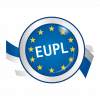The EUPL is the European Free/Open Source Software (F/OSS) licence. It has been created on the initiative of the European Commission. It is now delivered in 23 original linguistic versions and can be used by anyone for software distribution. The EUPL is OSI certified and considered as a Free Software Licence by the Free Software Foundation.
The current version (SPDX unique identifier) is the EUPL-1.2 (OJ 19/05/2017 L128 p. 59–64)
For licensing code (or any other copyrighted work) under the EUPL, It is enough, as stated at the beginning of the licence itself, to insert the mention "Licensed under the EUPL" in the source and documentation. This means applying the last (current) version of the licence. In case an explicit mention of the licence version needs to be done, the equivalent recommendation is to write: "Licensed under the EUPL-1.2-or-later".
What makes the EUPL unique and different from all other licences?
- The EUPL is a reciprocal (or share alike, or copyleft) licence, meaning that distributed contributions and improvements (called "derivatives") will be provided back or shared with the licensor and all other users. At the same time (and unlike other copyleft licences like the GPL or AGPL), the EUPL is compatible with most other open reciprocal licences and is interoperable. Summarising strongly, the EUPL functions as a LGPL covering remote distribution.
- Compatible means that the work covered by the EUPL can be used/merged and distributed in another work covered by GPL-2.0, GPL-3.0, LGPL, AGPL, CeCILL, OSL, EPL, MPL and other licences listed as outbound compatible in the EUPL Appendix. This applies to the other (combined) work that is a "derivative", while the original project must stay covered by the EUPL without re-licensing. Compatibility does not reduce the licensor obligations applied on derivatives, like the publication of the source code or the coverage of SaaS, because none of the compatible licences enter in conflict with the EUPL on these points. The compatible licence obligations will prevail when they conflict with those resulting from the EUPL.
- Interoperable means that the EUPL is applied according to the European Law (Directive 91/250/EEC, re-codified 2009/24/EC), even when used in other parts of the world, making clear that the covered interfaces, APIs and data structures may be freely copied and reused for implementing static or dynamic linking with any other independent component, without impacting the licence of this component.
- The EUPL is the sole really multilingual open source licence, where all 23 versions are original and have equal value;
- The EUPL covers "the Work" meaning any copyrighted material (i.e. software and ancillary data);
- The EUPL covers distribution through a network or SaaS (like a more compatible and interoperable AGPL) and includes a Developer Certificate of Origin (DCO) .

